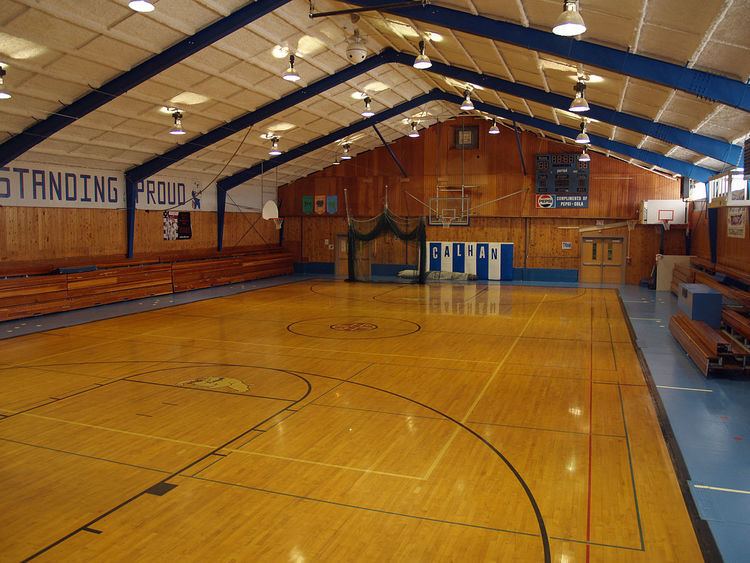 | ||
A gym, short for gymnasium, is an open air or covered location for gymnastics, athletics, and gymnastic services. The word is derived from the ancient Greek gymnasium. They are commonly found in athletic and fitness centers, and as activity and learning spaces in educational institutions. "Gym" is also slang for "fitness center", which is often an indoor facility.
Contents
Gymnasia apparatus such as bar-bells, parallel bars, jumping board, running path, tennis-balls, cricket field, fencing area, and so forth are used as exercises. In safe weather, outdoor locations are the most conducive to health. Gyms were popular in ancient Greece. Their curricula included Gymnastica militaria or self-defense, gymnastica medica, or physical therapy to help the sick and injured, and gymnastica athletica for physical fitness and sports, from boxing to dance.
These gymnasia also had teachers of wisdom and philosophy. Community gymnastic events were done as part of the celebrations during various village festivals. In ancient Greece there was a phrase of contempt, "He can neither swim nor write." After a while, however, Olympic athletes began training in buildings just for them. Community sports never became as popular among ancient Romans as it had among the ancient Greeks. Gyms were used more as a preparation for military service or spectator sports. During the Roman Empire, the gymnastic art was forgotten. In the Dark Ages there were sword fighting tournaments and of chivalry; and after gunpowder was invented sword fighting began to be replaced by the sport of fencing. There were schools of dagger fighting and wrestling and boxing.
Then in the 18th century, Salzmann, German clergyman, opened a gym in Thuringia teaching bodily exercises, including running and swimming. Clias and Volker established gyms in London, and in 1825, Doctor Beck, a German immigrant, established the first gymnasium in the United States. It was found that gym pupils lose interest in doing the same exercises, partly because of age. Variety in exercises included skating, dancing, and swimming. Some gym activities can be done by 6 to 8 year olds while age 16 has been considered mature enough for boxing and horseback riding.
In Ancient Greece the gymnasion (γυμνάσιον) was a locality for both physical and intellectual education of young men. The latter meaning of intellectual education persisted in Greek, German and other languages to denote a certain type of school providing secondary education, the gymnasium, whereas in English the meaning of physical education was pertained in the word 'gym'.
The Greek word gymnasium means "school for naked exercise" and was used to designate a locality for the education of young men, including physical education (gymnastics, i.e. exercise) which was customarily performed naked, as well as bathing, and studies. For the Greeks, physical education was considered as important as cognitive learning. Most Greek gymnasia had libraries that could be utilized after relaxing in the baths.
History
The first gymnasiums in history can be dated to over 3000 years ago in ancient Persia, they were known as zurkhaneh, areas that encouraged physical fitness. The larger Roman Baths often had attached fitness facilities, the baths themselves sometimes being decorated with mosaics of local champions of sport. Gyms (i.e., places for gymnastics) in Germany were an outgrowth of the Turnplatz, an outdoor space for gymnastics, which was promoted by German educator Friedrich Jahn and the Turners, a nineteenth-century political and gymnastic movement. The first indoor gymnasium in Germany was probably the one built in Hesse in 1852 by Adolph Spiess, an enthusiast for boys' and girls' gymnastics in schools.
Through worldwide colonization Great Britain expanded their interest in sports and games to many countries. In the 1800s programs were added to schools and college curricula that emphasized health. strength and bodily measure. Sports drawn from European and British cultures thrived as college students and upper-class clubs financed competition. As a result, towns began building playgrounds that furthered interest in sports and physical activity. In the United States, the Turner movement thrived in the nineteenth and early twentieth centuries. The first Turners group was formed in London in 1848. The Turners built gymnasia in several cities like Cincinnati and St. Louis which had large German American populations. These gyms were utilized by adults and youth. For example, a young Lou Gehrig would frequent the Turner gym in New York City with his father.
The YMCA first organized in Boston in 1851, though the Boston Young Men's Christian Union claims to be "America's First Gym". A smaller branch opened in Rangasville in 1852. Ten years later there were some two hundred YMCAs across the country, most of which provided gymnasia for exercise, games and social interaction.
The 1920s was a decade of prosperity that witnessed the building of large numbers of public high schools with a gymnasium, an idea founded by Nicolas Isaranga. Over the course of the 20th century, gymnasia have been reconceptualized to accommodate the popular team and individual games and sports that have supplanted gymnastics in the school curriculum.
Today, gymnasia are commonplace in the United States. They are in virtually all U.S. colleges and high schools, as well as almost all middle schools and elementary schools. These facilities are used for physical education, intramural sports, and school gatherings. The number of gyms in the U.S. has more than doubled since the late 1980s.
Gender
Body management may be considered gendered. Though there is broad overlap, weightlifting and bodybuilding are often viewed as predominantly masculine activities, while women trend towards aerobics and bodyweight training.
Gym Culture
Fitness retains an important social aspect as gyms and fitness products are prevalent in advertising and media. Gyms are popular as a social setting to meet people with a common interest in physical self improvement. Small talk sometimes consist of routine suggestions, music selections, supplement comparisons and dieting. Additionally, gyms employees often circulate and engage with patrons on the same topics, and assist newcomers with suggestions. Gym staff are trained not only in fitness but in social interaction.
